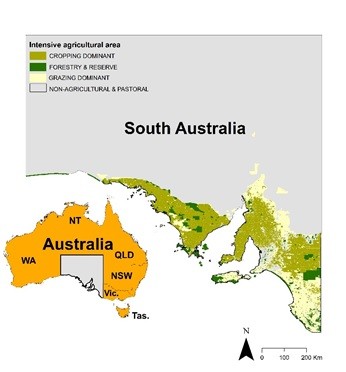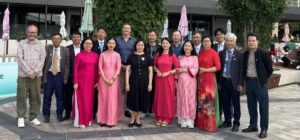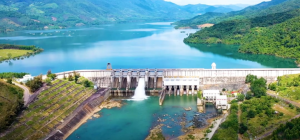The Goyder Institute for Water Research initiated the Carbon Offsets Research to Support the State Carbon Sequestration Strategy project to assess South Australia’s potential to offset emissions through land-use change and increase participation in the national Emissions Reduction Fund (ERF). The ERF has recently transitioned to the Climate Solutions Fund (CSF).
The ERF/CSF is one of the main mechanisms in Australia’s climate change policy. Funding is allotted through a reverse auction process, where prescribed actions that reduce or offset CO2 emissions can be offered in tender rounds. Funding is offered for the least cost per tonne CO2 offset offers. Most credits issued through the ERF have involved avoided deforestation and assisted natural regeneration of native vegetation, but other activities like building energy efficiency and reducing landfill methane emissions could receive credits. Only a fraction of one per cent of credits came from South Australia intensive agriculture areas (i.e. areas cleared for broadacre cropping/grazing), which represents approximately 10 million hectares (11 per cent of South Australia’s area).
The Institute brought together independent experts from UniSA, The University of Adelaide, SA Water, and the Department for Environment and Water (DEW) in the Carbon Offsets Research project, led by Professor Jeff Connor (UniSA). The team worked together to understand the economics of land-use change for carbon abatement across SA’s intensive agricultural zone and assess the potential of co-benefits from carbon plantings to contribute additional incentives and improve the economic viability of land-use change. The team also assessed policy context and stakeholder perceptions to understand what might be limiting landholder participation.
The team found that large-scale change to the primary carbon-sequestering land uses is unlikely in SA’s intensive agricultural zone at current and foreseeable carbon credit prices. Even at three times the current ERF auction price for credits, the economically-viable land-use change driven by carbon credit benefits alone is likely to provide only a small fraction of CO2 offsets relative to South Australia’s emissions.

In three case studies, the co-benefits of land-use change (including improved pollination, shelter belts to improve lambing yields, or riparian revegetation to improve water quality) showed possibilities of achieving economic viability. Pollination and reduced lamb mortality from strategic plantings provided some valuable farm production benefits but not enough for combined carbon and co-benefit values to offset implementation costs. Water quality benefits, in the form of avoided chemical water quality treatment costs, were closer to justifying carbon credits and co-benefits, and could be achieved through biodiverse carbon plantings along creek lines supplying the Happy Valley water treatment plant.
The research suggests that the role of carbon credits in incentivising additional revegetation over broad swaths of South Australia’s intensive agricultural zones is likely to remain economically challenging at current carbon prices. However, there are a number of bespoke and niche opportunities – where the opportunity cost of current land uses are low, additional co-benefits from the land use change are valued as substantial by the landowner, and where carbon sequestration potential is high.
Environmentally-beneficial carbon emissions abatement from land-use change in the state could also be improved by providing landholders with better information about ERF requirements, the economics of participation, and the potential value of co-benefits. More research is also recommended to understand how stacking multiple benefits, and developing methods to accurately account for variable carbon sequestration rates, can help improve the economic viability of land-use change.
Read on for more detailed information about our research or click to view our research reports:
Economic Methods for Assessing Carbon Offset Supply Cost, Assessing South Australian Carbon Offset Supply and Cost, and Assessing South Australian Carbon Offset Supply and Policy for Co-beneficial Offsets: Technical Estimation of Carbon Supply.
Economics of land-use change for carbon abatement
The economics of land-use change were assessed based on the actual methods that farmers must apply to participate in the Australian ERF. The ERF includes a number of different ‘methodologies’ in the vegetation management category and three were chosen to be assessed based on their applicability to SA:
- mixed environmental plantings (eligible across the state)
- monoculture mallee eucalypt (tree plantation) revegetation (eligible in drier areas with less than 600 mm rainfall)
- regenerating existing native vegetation by changing management (e.g. removing stock).
The official ERF Full Carbon Accounting Model (FullCAM) was used to estimate the annual and cumulative carbon sequestration over a 100 years (Richards and Evans, 2004) for a five kilometre GIS grid. Then, the carbon price needed to increase land-use change carbon credit returns above the expected future returns of current agricultural land use (plus establishment costs) was computed for each grid cell.
Results confirm that near zero carbon abatement supply can be expected with recent ERF prices of around $14 t CO2e when the most economical ERF method was considered (environmental plantings). At $50 t CO2e only 48 Mt CO2e is estimated over 100 years, less than 2% of emissions that could be expected from the State cumulatively over that period. Emissions reduction scenarios developed for the South Australian Government for a low emissions future (Hewson et al., 2015), showed that 12.7 Mt CO2e of residual emissions would need to be offset in that year to achieve neutrality by 2050. The research shows that it is not until prices reach approximately $124 tCO2e that residual emissions in 2050 could be offset by local economically-viable land sector abatement given actual ERF crediting requirements. This would require land use change in about 10% of SA’s eligible area.
Potential for additional benefits from land use change to improve economic viability
The project also investigated the potential value of co-benefits from carbon plantings across three case studies: pollination, shelterbelt, and riparian revegetation. Co-benefits could act as additional incentives to encourage wider adoption of land use change.
Pollination
A pollination co-benefit was assessed for carbon-sequestering trees bordering lucerne paddocks in the State’s southeast, where high value lucerne seed is produced. The research showed that the additional economic value of pollination was only a small fraction of the land-use conversion cost gap after carbon credit payments were accounted for, under nearly all scenarios. Under the most optimistic assumptions, the value of additional lucerne seed yield from pollination was estimated to cover 40% of the cost gap. While increasing pollinator habitat is beneficial, the team found that it was not in itself enough to offset the cost of land use change, even when the sequestered carbon could be sold at recent ERF carbon prices.
Shelterbelt
A shelterbelt case study in current sheep farming land-use areas showed that significantly higher than recent ERF carbon prices would be required for the combined economic value of shelterbelt carbon and lamb mortality reduction to justify implementation costs. The economics varies across the state depending on wind chill and rainfall, assumptions about proportions of twin versus single lamb litters, and the impacts of wind chill on mortality.

Riparian revegetation
A final co-benefits case study evaluated revegetation of cleared riparian areas to improve water quality and reduce water treatment costs in the Mt Lofty Ranges Happy Valley drinking water catchment. The value of carbon credits and avoided water treatment costs resulting from steam buffer plantings were calculated and compared to implementation costs and the team concluded that:
- Water treatment cost saving from strategic creek line revegetation may exceed the cost of the land use change.
- Summed values of water treatment cost saving and carbon make stream buffer tree plantings in water supply catchment even more economically viable.
- Strategic planting locations to improve water quality also yield high carbon and are good for biodiversity.
Stakeholder insights on impediments to land use change for carbon abatement
The project team interviewed landholders, government policy officers, and carbon credit brokers who were involved with or were contemplating land-use change for carbon credits. Interviews identified key issues related to the relative reticence of South Australian landholders to participate in the ERF. Important impediments included the perceived complexity of the ERF contracting process and the need for relatively large bundles of land-use change. These two requirements in combination have led to carbon brokerage services that provide program knowledge and smaller land-use change bundling services. This can be positive for landholders as it provides a viable market that is approachable, but commissions for the service can represent a substantial part of the credit payment value. Landholders also identified some conservative assumptions around carbon sequestration rate crediting, built into ERF guidelines, that would significantly reduce the economic viability of their participation.
Contact Professor Jeff Connor (UniSA) for more details about the project or get in touch with Goyder Institute Director Dr Kane Aldridge for more information about projects within the Institute’s Climate Action Impact Area.


